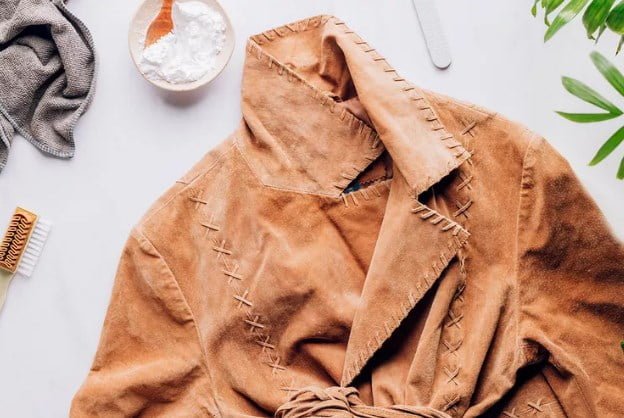Take these steps to get the grime off of your real suede jacket.
Apply Absorbent Powder, Then Brush
Sprinkle the stain with baby powder or cornstarch to absorb the oil.
Wait an hour and check the powder. The powder should begin to look oily after an hour or so. It is fine to leave the powder on the stain for more than an hour.
Brush away the oily-looking powder with a soft brush.
If the oil stain is gone, give the coat a good brushing overall with a suede brush.
If the stain remains, repeat the application of powder as many times as necessary until no more oil is absorbed.

How to Clean Other Stains From a Suede Jacket
If you have never worked with suede, always practice these steps on a small, hidden area first to avoid any discoloration or damage.
Food, Mud, and Other Wet Stains
When food or wet mud gets on a suede coat, do not rub the stain. Rubbing will only drive the stain deeper into the suede.
Use a blunt knife or the edge of a credit card to lift away as much of the wet solid matter as possible. There will be traces left that will be treated once the stain dries.
If the stain is caused by a liquid, use a paper towel or a clean white cloth to blot away as much moisture as possible. Put the cloth directly over the stain and apply some pressure to draw the moisture away from the suede and into the cloth. Keep turning the cloth to a clean, dry area and continue blotting. Allow the area to dry naturally away from direct heat.
Once the stained area has dried, it is easier to treat. Start with the most gentle treatment and move to more abrasive action. After every treatment, brush the area with the suede brush to restore and smooth the fabric.
Gently rub the area with a white, microfiber cloth to lift away as much of the dried-on matter as possible.
If that does not work, use a pencil eraser or art gum eraser to gently rub away the stain.
As a last resort, gently rub the stained area with an emery board nail file to remove the dried-on matter.
Sticky Residue
Sticky name tags or tape can leave a residue on suede when pulled off the coat. It’s best to avoid them altogether but if there is residue left behind, it is crucial to work slowly to loosen the sticky mess from the fibers of the suede.
If the sticker does not pull away easily, dampen it lightly with a wet paper towel. Use the edge of a blunt knife or credit card to gently pry loose a corner or gently scrape the sticker away.
Once the sticker is removed, allow the area to air-dry away from direct sunlight or heat. Brush with a suede brush, which sometimes is enough to remove all the sticky residue.
If residue remains, try an art gum eraser. Use short, gentle strokes, without hard scrubbing. The eraser should pick up any leftover glue in the fibers.
If the suede brush and art gum eraser didn’t completely remove the sticky residue, use an emery board to gently rub the area. Use a very light touch to prevent damage to the texture of the fabric.
How Often to Clean a Suede Jacket
After every wearing or at least weekly, use a soft-bristled suede brush on the surface to remove loose dust and soil. Regular brushing will help delay the need for professional cleaning. If you get caught in the rain, allow the damp suede to dry slowly away from direct heat or sunlight. You can then use the suede brush to raise any areas where the fabric has been crushed.
A suede coat should be professionally cleaned if it develops odors from perspiration or has significant stains. The coat should always be cleaned before storing it at the end of the season.
How to Care for a Suede Jacket
A two-sided suede brush is a must-have item if you have a quality suede coat. Inspect your jacket after each use. Use the wire side when removing dried mud, dirt, or other staining material, and use the soft side to buff the nap. Brushing should be done only when the jacket is completely dry, and never use hard pressure, which can damage the surface of the leather.
When new, applying a protective suede conditioner will make your jacket less likely to absorb stains. Never use ordinary leather polish on suede, however. A suede protector will also guard your jacket against water.
Holes and rips are generally best handled by a professional, though there are a number of leather repair kits you can buy if you want to try your own repairs.
Ironing a suede surface is not recommended. But you can sometimes remove wrinkles by turning the jacket inside out, draping it with a protective cotton cloth, and lightly ironing over the cloth using a low-heat setting.
How to Store a Suede Jacket
Leather coats and jackets should be stored by hanging them on a well-fitting wooden or fabric-covered hanger, and hung in a well-ventilated place that’s out of direct sunlight. Never store a leather coat folded up or in a closed container.


